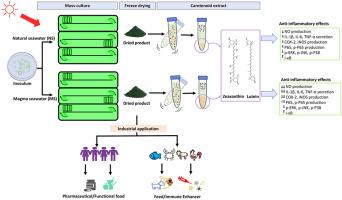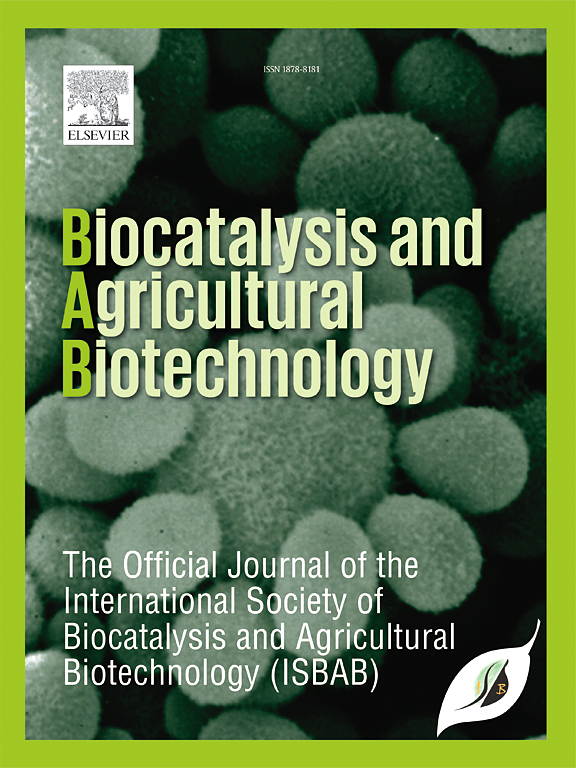比较天然海水和岩浆海水中大量培养的微藻富含的类胡萝卜素的抗炎作用
IF 3.4
Q2 BIOTECHNOLOGY & APPLIED MICROBIOLOGY
引用次数: 0
摘要
微藻可在短时间内大量生产,且富含类胡萝卜素等高附加值产品,因此被广泛应用于各种工业领域。然而,由于培养原料维生素的价格昂贵,生产成本消耗很大。此外,80% 的合成类胡萝卜素用于工业领域,其成本也很高。因此,本研究使用天然海水(NS)和岩浆海水(MS)作为维生素,大规模培养了一种微型藻类--Tetraselmis sp.。比较在两种培养基中培养的提取物的总体成分,发现在 MS 培养基中,粗碳水化合物和粗脂肪含量分别高出 2.68% 和 4.38%,而粗蛋白含量则低 4.1%。MS 培养基的提取率比 NS 培养基高 8.6%。此外,叶黄素和玉米黄质主要存在于物种中,在 MS 培养基培养的微藻提取物中检测到的叶黄素和玉米黄质分别是 NS 培养基的 2 倍和 8 倍。因此,用两种海水培养的富含类胡萝卜素的提取物通过 MAPKSs 和 NF-κB 通路抑制一氧化氮(NO)的过量产生和肿瘤坏死因子(TNF)-α、白细胞介素(IL)-1β、IL-6、诱导型一氧化氮合酶(iNOS)和环氧化酶(COX)-2 等促炎介质的表达,具有显著的抗炎作用。有趣的是,在 MS 中培养的微藻提取物显示出更有效的抗炎作用。这些结果表明,在大量培养微藻的过程中,MS 在增加类胡萝卜素含量方面具有重要价值,并能产生有益的影响。本文章由计算机程序翻译,如有差异,请以英文原文为准。

Comparison of the anti-inflammatory effects of carotenoids-rich product from microalgal mass-cultured between natural seawater and magma seawater
Microalgae can be mass-produced in a short period of time and are rich in high value-added product such as carotenoids, thereby it is widely used in a variety industrial field. However, the production cost expensed a lot due to high price of culture ingredient, vitamins. Additionally, >80% of synthetic carotenoids are used in industrial field, and their cost is also highly expensed. Therefore, in this study, a microalga, Tetraselmis sp. was mass-cultured using natural seawater (NS) and magma seawater (MS) as vitamins. As a result of comparing the general composition between the extracts cultured in two culture media, crude carbohydrate and crude lipid contents were 2.68% and 4.38% higher, respectively, while crude protein content was 4.1% lower in the MS culture media. The extraction yield was 8.6% higher in the MS than the NS culture media. Also, lutein and zeaxanthin were predominantly presented in the species and detected in the microalgal extract cultured in MS was 2- and 8-folds higher, respectively, than in NS. Consequently, the carotenoids-rich extracts cultured with two seawaters were exhibited prominent anti-inflammatory effects by suppressing nitric oxide (NO) overproduction and pro-inflammatory mediator such as tumor necrosis factor (TNF)-α, interleukin (IL)-1β, IL-6, inducible nitric oxide synthase (iNOS), and cyclooxygenase (COX)-2 expression through MAPKSs and NF-κB pathway. Interestingly, extract of microalgal cultured in MS showed a more efficient anti-inflammatory effect. These results suggest that the value of MS in increasing the carotenoids contents with beneficial effects in mass cultivation of microalgae.
求助全文
通过发布文献求助,成功后即可免费获取论文全文。
去求助
来源期刊

Biocatalysis and agricultural biotechnology
Agricultural and Biological Sciences-Agronomy and Crop Science
CiteScore
7.70
自引率
2.50%
发文量
308
审稿时长
48 days
期刊介绍:
Biocatalysis and Agricultural Biotechnology is the official journal of the International Society of Biocatalysis and Agricultural Biotechnology (ISBAB). The journal publishes high quality articles especially in the science and technology of biocatalysis, bioprocesses, agricultural biotechnology, biomedical biotechnology, and, if appropriate, from other related areas of biotechnology. The journal will publish peer-reviewed basic and applied research papers, authoritative reviews, and feature articles. The scope of the journal encompasses the research, industrial, and commercial aspects of biotechnology, including the areas of: biocatalysis; bioprocesses; food and agriculture; genetic engineering; molecular biology; healthcare and pharmaceuticals; biofuels; genomics; nanotechnology; environment and biodiversity; and bioremediation.
 求助内容:
求助内容: 应助结果提醒方式:
应助结果提醒方式:


